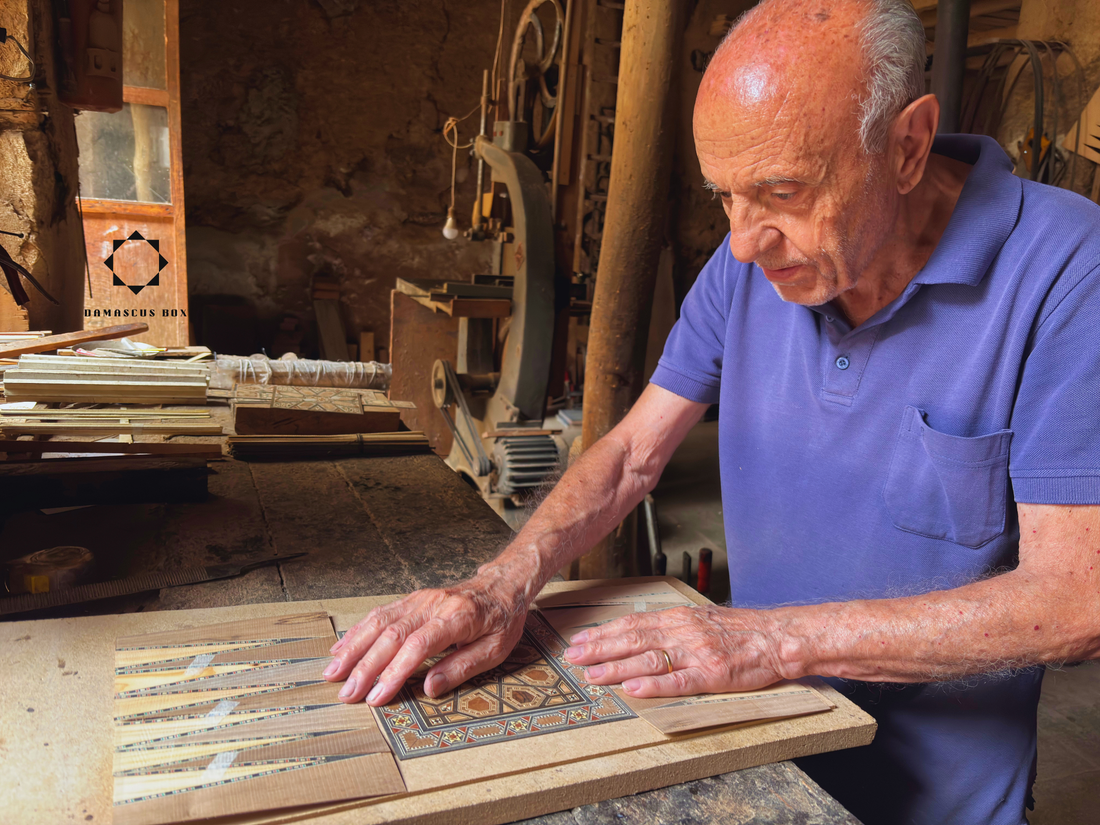
Gaby Aldayeh, known as Abu Boutros – Master of Damascene Mosaic
Share
Told by Yazan Krayem – Founder of Damascus Box.
In one of the narrow alleys of Old Damascus, behind carved wooden doors, the gentle hum of a small saw fills the air, mingling with the scent of wood after the traditional Damascene polishing method (al-bardakha). Sunlight slips through the wooden shutters, illuminating boxes, trays, and mosaic panels waiting for their final touch.
At the center of this world sits Gaby Aldayeh, known affectionately as Abu Boutros – a name that in Damascus carries both respect and warmth.
Abu Boutros is ninety years old and has practiced this craft for more than seventy-five years. He smiles with the calm of someone who has spent a lifetime shaping beauty with his hands:
“I was fifteen when I started. My father took me out of school and said, ‘You’ll work with me.’ That was in the early 1950s, and since that day I’ve never left the trade.”
He learned in the old Damascene way – through observation, repetition, and endurance.
“Back then we didn’t have many choices,” he says, “but with time I fell in love with it. It became my life.”
The Art of Geometry and Patience
The Damascene mosaic is among Syria’s most intricate and refined crafts, blending geometry, precision, and devotion into a harmony that borders on the sacred.
Its roots go back nearly two centuries to Gerji Al Bittar, the Damascene carpenter who transformed simple woodworking into a national art form.
Born in 1840 in the Christian quarter of Bab Touma, Al Bittar developed the idea of inlaying different kinds of wood—such as walnut, lemon, rosewood, eucalyptus, and olive—with bone, ivory, and mother-of-pearl.
From his small workshop he crafted masterpieces that soon decorated churches, palaces, and homes throughout Damascus, then spread abroad to places as distant as Vienna, Paris, and even the United Nations Headquarters.
His tables and cabinets were offered to Pope Pius X at the Vatican and to Sultan Abdul Hamid II, earning him medals and international acclaim.
Yet Al Bittar never sought patents or exclusive rights; he wanted his craft to belong to the people. His legacy became the foundation of a living tradition that generations of Damascene artisans—like Abu Boutros—still honor today.
Abu Boutros continues this heritage with quiet pride. He explains how every piece begins with thin rods of lemonwood, rosewood, beech, eucalyptus, and walnut, whose natural colors form a palette richer than any paint. These rods are cut, glued, and wrapped by hand into tiny triangles, stars, and diamonds, bundled and sliced again—layer upon layer—until the desired pattern emerges.
Holding a piece up to the light, he says:
“Everything we do is by hand. We cut each shape one by one, glue it, roll it, and cut it again. Every part becomes a piece of something bigger—like life itself, built little by little.”
The finished surfaces glow with warmth: boxes, trays, chessboards, mirrors. Each carries the spirit of Damascus—calm, precise, and timeless. In every pattern lies a balance between order and spontaneity, as though centuries of craft and a moment of inspiration met within a single line.
A Father’s Legacy, Hands of Memory
Abu Boutros often speaks of his father, the man who taught him patience and precision.
“It’s not easy work,” he says. “It takes time, focus, and steady hands. But when you love what you do, the fatigue disappears.”
He still uses the same tools his father used decades ago—handles worn smooth, faded blades, and a wooden table that has witnessed a lifetime of creation. His workshop feels like a living archive: mosaics from every decade neatly lined on the shelves, each telling a fragment of the city’s story. The patterns echo the rhythm of Damascus itself—its courtyards, domes, and unending patience.
Changing Times
Despite his quiet pride, a hint of worry touches his voice.
“Young people today want degrees and office jobs,” he says. “They don’t want to work with their hands. Back then, universities weren’t a popular choice; workshops — often the family business — were where we truly learned a craft.”
He pauses, running his fingers across a polished mosaic box that gleams like a mirror.
“We are the last generation. Maybe after us no one will remain. But what we’ve made will stay—every box, every line tells a story.”
His words mix sadness with serenity—the wisdom of someone who has seen change without abandoning passion.
“I still work the old way,” he adds. “As long as my hands can move, the craft will live.”
The Spirit of Damascus
Mosaic has never been mere decoration. It is a meeting between mathematics and imagination, order and emotion—a reflection of Damascus itself. Each geometric pattern carries a silent philosophy: beauty is built step by step, with patience, faith, and love.
Abu Boutros embodies that philosophy. His life and work remind us that true art is not made for fame or fortune but to honor the past and preserve identity. In the balance of his delicate patterns lives the history of Damascus—ancient yet alive, ever changing yet eternal.
As the evening light fades in his workshop, Abu Boutros sets down his tools and brushes the fine dust from his hands. Around him, the finished pieces shine softly—each a testament to skill and devotion. He smiles, the same gentle smile of the fifteen-year-old boy he once was, and says:
“I’m still here, working the way my father taught me.”
A Living Heritage
Through the hands of great craftsmen like Abu Boutros, the radiance of Syrian artistry endures. Their work preserves the memory of a city and a culture that has offered the world some of its most intricate beauty.
Written by Yazan Krayem
At Damascus Box, we are proud to honor and support these master artisans who keep the soul of Syrian craftsmanship alive—piece by piece—reminding us that true creativity lies not only in what we make, but in what we keep alive.
